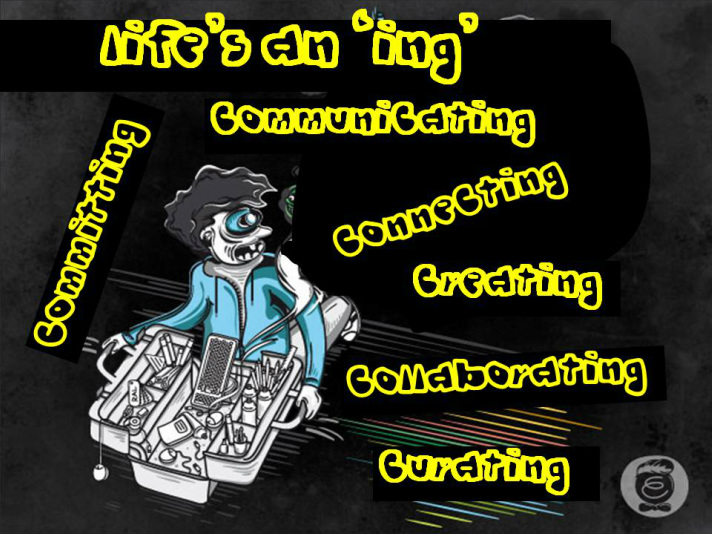 In this final reflection I look back on my own engagement with the process and what I gained from it. My overall sense is that the time I invested was worthwhile. I think I probably invested about 20 hours through the week on exploring and trying to use some of the tools, reflecting on my own practices, attitudes and behaviours and the circumstances in which I use these digital/media tools, writing up my thoughts under each theme and listening to the daily twitter conversation. Perhaps the missing C that kept being talked about was commitment. There is an opportunity cost in engaging with technology initially to be competent and confident in using it and then to apply it. It doesn't always work and I had many instances during the week when what I tried didn't work and I was both frustrated and demotivated. I also lost my power lead to my tablet and managed to pick up something through my downloads. I was grateful to the person who tweeted that they had had trouble with an app. I often have trouble trying to make things work and this aspect of learning often gets glossed over in the enthusiasm for the technology. In fact my criticisms of the experience were in the overwhelming positivity and enthusiasm expressed by participants - not surprising given that many were in the business of promoting these technologies and were so familiar with them that they didn't give it a second thought. Perhaps there is a need for BYOD4L 'for beginners'. Accepting that I probably wasn't typical of the participants in that I didn't have a teaching role within an organisation. The things I valued most which worked best for me were: 1 The resources. Sue's collections of tools and the introductory videos are a great resource that I have embedded in my own website for future use. I didn't find the scenarios useful. 2 Examples and illustrations of the use of the technologies.. these were great in showing what could be done. In particular some of the curatorial tools like scoop.it and paper.li. The twitter conversation was I felt conducted between like minded people who are genuinely enthusiastic about the use of devices and tools. The sheer volume of tweets was overwhelming more like a brainstorming exercise. I found reading some of the more considered reflections more valuable. What was great was seeing the enthusiasm, commitment, teamwork, care and attention and personal support the facilitators gave to the process and the people in it. A real lesson in the energy, passion, care, dedication and expertise necessary to make these sorts of learning experiences work. I gained useful insights into what had to be done to make this form of learning work. Offline I had some good conversations with my son who managed to spend a bit of time looking at the resources and tuned into the twitter conversation most evenings. So it achieved that objective. The tension for me throughout the BYOD4L experience was the push towards using mobile devices (not surprising given that this is what it was about) when my preferred device - because I am mainly based at home, is my laptop. But restricting myself to my laptop means I cannot access apps which are only designed for mobile devices. But by the end of the week I could see that my own work to support LWE could be enhanced with the selective use of mobile devices and some of the tools. More importantly I decided that my need to embrace these new media tools is not so much driven by own interests but by the interests of others who want to express themselves using the technologies that they prefer to represent their own learning, development and achievement and this changed my perspective. Throughout the week I tried to reflect on my own attitudes and practices in the contexts of my own circumstances and I will continue to do so over the next few weeks and try out some more of the tools. The idea of structuring the experience around five key concepts really helped focus attention on key aspects of living, working and playing in the digital world and for me these were powerful reflective prompts which also triggered my creative juices. The magical box that was the course did indeed promote and enable all these things which are all fundamental to learning, development and achievement - communicate, connect, collaborate, create and curate. In addition it encouraged participants to commit and enabled them to contribute and learn in the process of co-creating some of the content. Thanks to all who designed and facilitated the process and experience. It was an interesting and enlightening experience. 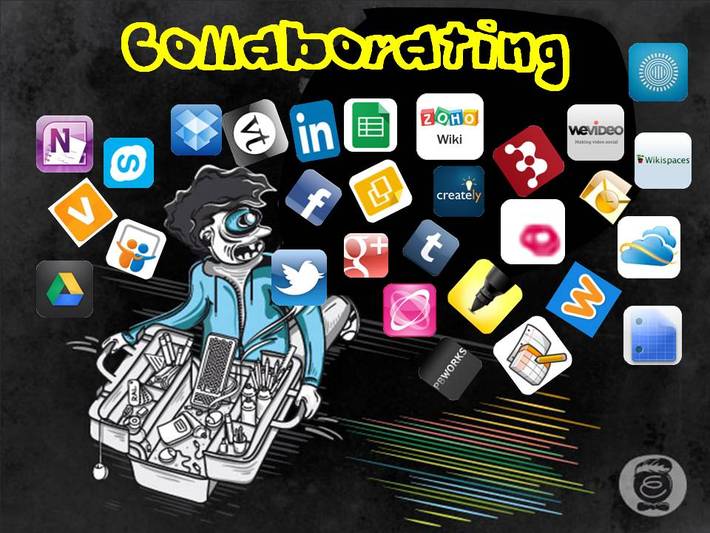 Life's an 'ing' - collaborating - visioning, leading, self-organising, connecting, interacting, teamworking, coordinating, combining, partnering, facilitating, pooling, exchanging, communicating, co-producing, co-creating, co-authoring, sharing, collating, synthesising, energising, encouraging, supporting, empathising, respecting, valuing, validating - learning partnerships Collaboration is the name we give to a process where people work together to achieve something they collectively value - a common project. Whether it is formal education or informal learning and development collaboration requires individuals to participate in a social process of knowledge construction often associated with making, producing or performing something. Knowledge is co-created by participants and emerges through a network of interactions and conversations and distributed and mediated by the people and the tools that they use for interacting. Most of my working life has been spent in working or research collaborative ventures either with one or two individuals, small teams (less than 10), larger communities of interest or sometimes personally constructed networks of individuals. When I look back over 40 years my earliest collaborations involved writings on type writers then exchanging scripts and annotating them or literally cutting and pasting. In the 1980's word processing and email changed all this and now there are many tools to help with co-creation and sharing of knowledge and co-authoring of works. In my own life my main collaborative projects are involved with Lifewide Education. The very idea is founded on a community of interest in which people 'collaborate' simply by wanting to identify with a vision and stay connected to the information and knowledge that is being produced. This is the loosest notion of collaboration - associating with ideas. But within this project there are other collaborations - around the production of a magazine, e-books and conference for example. These forms of collaboration involve co-production of knowledge and the pooling of talents (including editorial and illustration) to produce quality works. Mostly we exchange stuff and have conversations via email. We find that this works well for us. Our research involves surveys and we have a dedicated website to enable people to contribute to on-line surveys. We also create fora for people to exchange their insights like the creativity in development site. I have used wikis (PBworks) in the past to support collaborations but not at the moment. 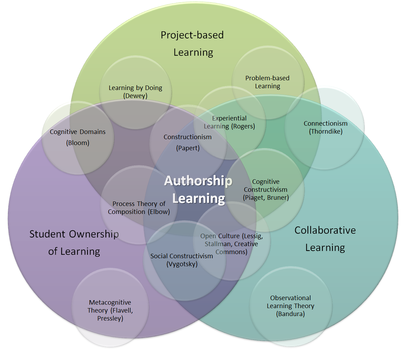 I felt that I didn't really need the sorts of collaborative tools that were being highlighted in BYOD4L and then I read an inspiring story of self-discovery told by Jonan Donaldson an instructional designer at Oregon State University and I realised that I had also made this journey. 'New digital tools available to students have flung open the doors to creativity, imagination, and student-directed learning. The sheer number of possibilities is daunting for any educator. Educational theory can help guide our choices and guidance of student learning. Constructionism has inspired me like no other idea in education has ever inspired me'. Our Learning Lives Challenge invites anyone to create a story about learning and development in any aspect of their lives using any medium and any digital tools to create their story. So my need is driven not by own interests but by the interests of others who want to express themselves using the technologies that they prefer to represent their own learning, development and achievement and this gave me another perspective on collaboration. Namely when a teacher relinquishes control over the way learning and development are recorded and represented and an author chooses to represent their learning using a particular device or tool, the teacher enters a partnership in learning in which their role is to try to utilise the particular technology, even if they are not familiar with it. Chrissi introduced me to Paper.li - a tool for collaboratively producing content primarily drawn from the twittersphere. Here is my first attempt at using it. 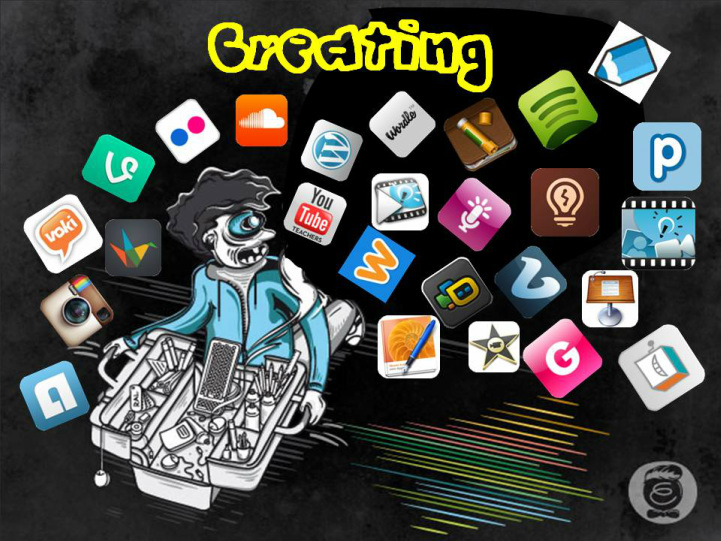 The final day is devoted to creating which I take to mean bringing something that is new to me into existence ie this blog and all the 'ing's' that make up the BOYD4L are potentially aspects of creativity and creating. I'm currently interested in the idea of creativity in development and with Chrissi have designed a process to enable people to share their perspectives on how it emerges from development. The narrative illustrates the process of having a novel idea, developing the idea and then making it a reality. It connects and integrates the ideas of creativity in imagining, developing, making, inventing, adapting and innovating. The focus for BYOD4L is on the way in which devices and tools enable the creative process. As far as my own experience and practice Web 2.0 tools have profoundly affected my ability to be creative/ inventive in my work in education and I'm grateful to all the people who have introduced tools and helped me use them over the years. Simply being able to create websites through drag and drop technology has enabled me to disseminate my ideas and create the infrastructure to support LWE. Sue's collection of tools is really useful and there are many with which I'm not familiar. I will over the next few weeks try to work through them to discover which ones I can use. I spend a lot of time creating visual aids like the narrative above to explain ideas and I'm conscious of mixing conventional tools like powerpoint, paint, photoshop, drawing on collections of images and working with illustrators as well as harnessing some of the tools below. A good example of this is my use of the explee animation tool described in my blog of 27/01.. to produce these animations I worked with two different illustrators some time ago - at that time I helped them shape their illustrations. These were then filed ready for retrieving at some point in the future. That moment came when I discovered explee (thanks to Chrissi). I retrieved the drawings and did some editing using paint, photoshop and powerpoint before uploading to explee and then embedding the result in this website. They were entirely new representations that have meaning and value to me. Creativity in the digital world is often a combination of many things but it emerges through the purposes and circumstances of our life. Over the next few weeks I intend to try out some of these tools. |
Answer Garden
click on link to expand ANSWER GARDEN
click on link to expand AuthorI love finding new tools that open a whole new world of creativity ArchivesCategories
All
|
BYOD4L BLOG
I wrote this blog during the week of the Bring Your Own Device for Learning open on-line course.
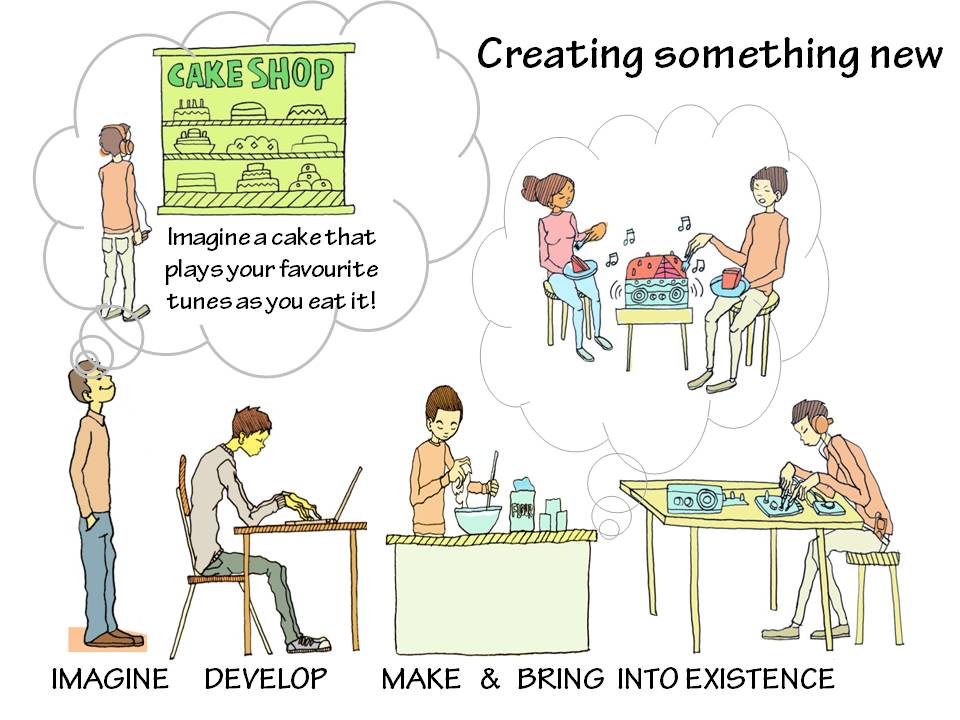
 RSS Feed
RSS Feed